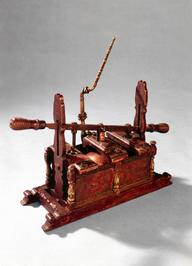

Wasabi gas spray system alarm, by Air Water Safety Service Inc, Japan, 2009. Still in packaging.
This is an award-winning smoke alarm which utilises somatosensry processing rather than noise to warn people of a fire. As such it is of particular use for both the hearing impaired. The alarm was developed partly in response to the rapid ageing and increasing frailty of Japan's population. Research suggests that most of those killed in building fires are either asleep or elderly. The research was conducted by a research team comprised of Makto Imai from department of psychiatry at Shiga University of Medical Science:, Junichi Murakami. The team found that both those with unimpaired and those with impaired hearing were woken by the wasabi - with the hearing impaired woken faster than those with 'normal' hearing. The aim was to ensure people wake up within three minutes - most waking within a minute or two.
The researchers tried hundreds of odors, including rotten eggs but wasabi was found to be the best. They isolated the compound in wasabi responsible for the characteristic stinging sensation -allyl isothiocyanate. Wasabi plants produce it as a defence against being eaten This active ingredient - the same chemical compound that is found in mustard - acts as an irritant in the nose.
Although people's sense of smell lessens when asleep, the chemical in wasabi also stimulates the pain receptors in your nose because the chemical is a 'somoatosensation.' The nervous system perceives it as painful, stinging feeling. 'In contrast to olfactory processing, somatosensory processing persists during sleep' according to Makoto Imai ' That's why [people] can wake up after inhalation of air-diluted wasabi' According to Popular Mechanics ' For their tests, Imai and colleagues filled the canisters of the compound, waited until their test subjects were deeply asleep and then filled the room with wasabi gas. Of the 14 test subjects - including four who were deaf - 13 woke within 2 minutes (it turned out the fourteenth person had a blocked nose.) The team actually tested about 100 odors, including rotten eggs. Wasabi stood alone as the premier waker-upper' 'We tested many different scents, but we found that the chemical components of wasabi make it difficult for people not to wake up when it is released' said Chingusa Shimokawa of Seems, a Tokoyo company that is distributing the Wasabi Odour fire alarm.
Their invention is now registered under a US patent called 'Odor Generation Alarm and Method for Informing Unusual Situation'. Media coverage of the device was extensive in 2010-11 and the device won the Ig Nobel Chemistry award for its Japanese scientists in 2011 at Harvard University. The research was one of 10 areas celebrated. The awards, a spoof of the Nobel prizes , 'honor achievements that first make people laugh, and then make them think'
Details
- Category:
- Firefighting
- Object Number:
- 2018-589
- Measurements:
-
overall (alarm): 210 mm x 80 mm x 55 mm,
overall (smoke detector): 105 mm x 105 mm x 25 mm,
- type:
- alarm




